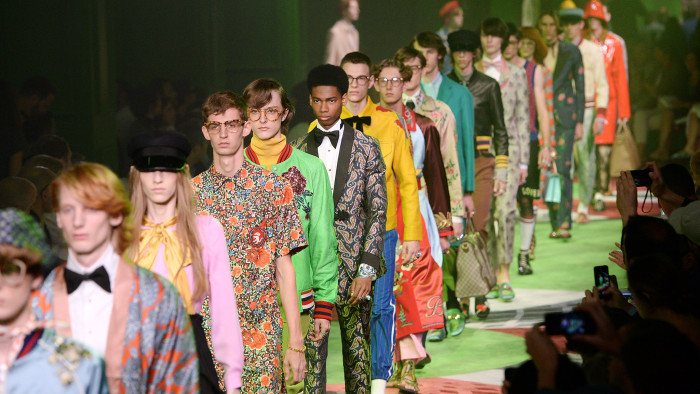He feels pretty: why menswear is borrowing from the girls

Simply sign up to the Life & Arts myFT Digest -- delivered directly to your inbox.
Does fabric have an inherent gender? As menswear designers continue to surprise with their use of lace, floral silk, chiffon and bouclé, what does the use of textiles more commonly associated with womenswear mean? These materials aren’t merely attention-seeking runway showpieces: they are at the core of many collections. So is it a case of novelty, subversion or part of a complex shift towards gender-neutral fashion?
Carlo Brandelli at Savile Row tailors Kilgour has been using bouclé — a wool as integral to the feminine lexicon of Chanel as its N°5 fragrance — for more than a decade. “I use the same mill as Chanel and have no hesitation in using fabrics associated with womenswear,” he says. “It was always very bizarre to me that fabric manufacturers set separate appointments for men’s and women’s textile collections. Then, when I started designing my own fabrics in 2004 it meant I could dictate the brief completely.”
Brandelli’s tailoring is austere and masculine but its design is driven by texture. Like the dazzling brocade bomber jackets at Dries Van Noten, or Alexander McQueen’s Victorian moth foil embroidery this season, it fits with a growing trend in menswear.
If fashion is cyclical (and of course it is), this is one loop that’s taken longer than most to complete: we haven’t really seen it since the 18th century. “Textiles only became ‘gendered’ in the 1790s, during and after the French Revolution,” says fashion historian and author Judith Watt. “After that date, decorative clothes for men — lace, velvet, woven fabrics like brocade, anything that was pretty — were verboten. The French adopted a masculinity defined by English sporting dress. But now it’s come full circle. It doesn’t really matter any more, does it? There’s no fence between masculine and feminine.”
Textiles undeniably carry meaning. Consider the artist Joseph Beuys, whose use of grey felt was explained via an (apocryphal) story involving nomadic Tartars, who he said had wrapped him in it after his plane crashed in the Crimea. See also British-Nigerian artist Yinka Shonibare — who is the subject of an exhibition at Stephen Friedman, London, until November 5 — who is celebrated for his colonial-era dresses, produced in the bright and graphic Dutch wax fabric so associated with African style.
These are textiles as pure statement. In fashion, the meanings attributed to certain fabrics continue to change. In the mid-1960s, Norman Mailer punched Warhol acolyte Mark Lancaster because Mailer took offence at his pink linen jacket. Fifty years later, and Italian boutique Luisa Via Roma is currently selling a Saint Laurent hot pink mink coat for men (its price is just shy of £17,000).
Flamboyance for most of the 20th century was synonymous with homosexuality. But recent years have seen high fashion becoming more fluid in its approach. Gucci designer Alessandro Michele insists that his designs for men and women all start from the same source and uses the same pinky silks, vibrant prints and richly embellished materials across both his men’s and women’s labels. When Gaultier showed men in skirts in 1984 it was hugely controversial; now skirts are a staple at Dries Van Noten, Rick Owens and Yohji Yamamoto. The actor Jaden Smith starred in a Louis Vuitton campaign this year wearing a skirt. And why not? It’s just a kilt with a twist.
This breaking down of gender boundaries has been most apparent in textiles, spurred on by young designers such as 2016 LVMH prize winner Grace Wales Bonner. Her menswear has drawn equally on the dandy look of Quentin Crisp in the The Naked Civil Servant as it has the decorative ceremonial style of Haile Selassie.
“I never thought when I started my career that I would be working with sequins, bouclé and Lurex,” says Damien Paul, who is head of the menswear buy at Matchesfashion.com, “but the modern man is embracing more feminine aspects of style. I think men are open to experimentation as long as the fabrics are used on a traditionally masculine shape.”
Gucci is one of the bestselling brands at Matches Fashion. Also popular is the young British designer Craig Green, whose autumn line is full of military green bouclé. “Textile is always a main starting point for every collection,” Green explains. “I was a textiles graduate at Central Saint Martins and I have always been obsessed with ideas of process and the properties of what a fabric can do or be.”

Silk jacquard is another newer textile appearing on Savile Row. “We have shown at least one silk jacquard dinner jacket for the last few seasons,” says Mark Frost, design director at Gieves & Hawkes. “It brings detailed patterns to life with a depth and richness. It takes evening dress to a heightened level of sophistication.”
That richness is one of the key reasons the gender distinctions are blurring: womenswear textiles tend to be more luxurious — and much of menswear is becoming more luxe. “Think about visiting an old country house,” suggests Watt. “Imagine running your hand over a tweed coat in the gun room. It’s masculine, prickly and heavy. Then imagine, instead, silk brocade. It is erotic and sensual, like a fur. The bouclé at Chanel is soft and sensual. Fashion is all about what’s new, and these textiles haven’t been used for menswear for ages.”
“Texture has always been proposed as a female option in fashion”, says Brandelli. That’s no longer the case. “We’re talking about something that doesn’t look throwaway,” adds Watt of the move towards a more careful, luxuriance in menswear. “It is anti-fast-fashion. Fundamentally, it’s something that Philip Green can’t reproduce.”
Photographs: Catwalking
Comments